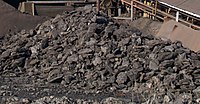
Photo from wikipedia
Abstract This study is devoted to characterizing the coal pyrolysis performance based on field effects in five fixed-bed reactors with different radiuses. The results showed that the increased reactor radius… Click to show full abstract
Abstract This study is devoted to characterizing the coal pyrolysis performance based on field effects in five fixed-bed reactors with different radiuses. The results showed that the increased reactor radius raised the coal bed thickness, thereby modifying the temperatures and extending the reaction time to reach 500 °C. At a furnace temperature of 900 °C, the increased coal bed thickness from 20 mm to 100 mm decreased the tar yield from 7.24 wt% to 5.62 wt%, while it raised the light tar content from 76.4 wt% to 83.0 wt% in the reactor with internals (reactor B). In contrast, in the reactor without internals (reactor A), the tar yield varied marginally and remained at 4.73 wt% but the light tar content increased from 69.5 wt% to 74.7 wt%. The increased coal bed thickness resulted in an increase in the tar quality but a decrease in the gas HHV (higher heating value) for both reactors. However, with the increase of coal bed thickness, reactor B always provides a higher yield and quality of tar and gas but lower pyrolysis water yield than reactor A, indicating that the internals suppressed the secondary reaction of pyrolysis products and the increase in coal bed thickness did not weaken this advantage of internals. The char HHV located in the center of the reactor with internals was higher than that of the reactor without internals; this was postulated that the pyrolysis products escaped from the central low-temperature coal bed, which enhanced carbon deposition. As expected, EDS results proved the postulation and showed that the char in the center of the reactor B had more carbon species. In addition, the color changes of quartz sand in the before and after tests first verified the flow field of pyrolysis products in phenomenology.
Journal Title: Fuel
Year Published: 2017
Link to full text (if available)
Share on Social Media: Sign Up to like & get
recommendations!